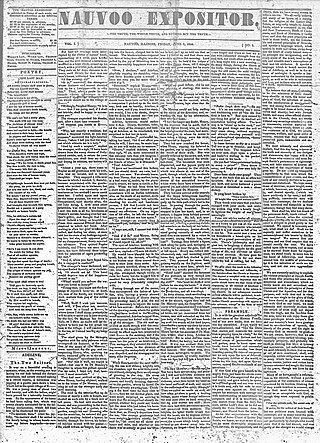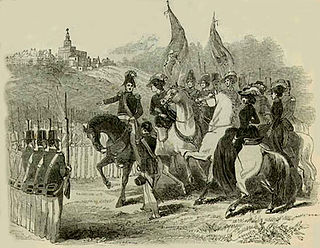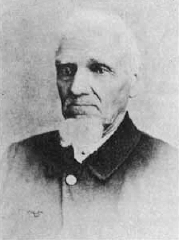
Nauvoo is a small city in Hancock County, Illinois, United States, on the Mississippi River near Fort Madison, Iowa. The population of Nauvoo was 950 at the 2020 census. Nauvoo attracts visitors for its historic importance and its religious significance to members of several groups: The Church of Jesus Christ of Latter-day Saints; the Community of Christ, formerly the Reorganized Church of Jesus Christ of Latter-day Saints (RLDS); other groups stemming from the Latter Day Saint movement; and the Icarians. The city and its immediate surrounding area are listed on the National Register of Historic Places as the Nauvoo Historic District.

The Nauvoo Expositor was a newspaper in Nauvoo, Illinois, that published only one issue. Its publication, and the destruction of the printing press ordered by Mayor Joseph Smith and the city council, set off a chain of events that led to Smith's arrest for treason and subsequent killing at the hands of a lynch mob.

The Latter Day Saint movement is a religious movement within Christianity that arose during the Second Great Awakening in the early 19th century and that led to the set of doctrines, practices, and cultures called Mormonism, and to the existence of numerous Latter Day Saint churches. Its history is characterized by intense controversy and persecution in reaction to some of the movement's doctrines and practices and their relationship to mainstream Christianity. The purpose of this article is to give an overview of the different groups, beliefs, and denominations that began with the influence of Joseph Smith.

The Nauvoo Legion was a state-authorized militia of Nauvoo, Illinois, United States from February 4, 1841 until January 29, 1845. Its main function was the defense of Nauvoo and surrounding Latter Day Saint settlements, but it was also occasionally used as local law enforcement and paraded at ceremonies such as the laying of the cornerstone for the Nauvoo Temple. The Nauvoo Legion was unique among contemporary militias for its chain of command structure, its expanded functions of the court martial, and for operating at a city level.

William Smith was a leader in the Latter Day Saint movement and one of the original members of the Quorum of the Twelve Apostles. Smith was the eighth child of Joseph Smith Sr. and Lucy Mack Smith and was a younger brother of Joseph Smith Jr., the founder of the Latter Day Saint movement.
The True Church of Jesus Christ of Latter Day Saints or True Mormon Church was a denomination of the Latter Day Saint movement. It was founded in the spring of 1844 in Nauvoo, Illinois, by leaders dissenting from the Church of Jesus Christ of Latter Day Saints.

John Cook Bennett was an American physician and briefly a ranking and influential leader of the Latter Day Saint movement, who acted as mayor of Nauvoo, Illinois, and Major-General of the Nauvoo Legion in the early 1840s.

The life of Joseph Smith from 1839 to 1844, when he was 34–38 years old, covers the period of Smith's life when he lived in Nauvoo, an eventful and highly controversial period of the Latter Day Saint movement. In 1844, after Smith was imprisoned in Carthage, Illinois, he was shot and killed when a mob stormed the jailhouse.

Joseph Smith, the founder and leader of the Latter Day Saint movement, and his brother, Hyrum Smith, were killed by a mob in Carthage, Illinois, United States, on June 27, 1844, while awaiting trial in the town jail on charges of treason.

Thomas Coke Sharp was a prominent opponent of Joseph Smith and the Latter Day Saints in Illinois in the 1840s. Sharp promoted his anti-Mormon views largely through the Warsaw Signal newspaper, of which he was the owner, editor, and publisher. Sharp was one of five defendants tried and acquitted of the murders of Smith and his brother Hyrum.

Reynolds Cahoon was an early leader in Latter Day Saint movement and later, in The Church of Jesus Christ of Latter-day Saints. He was one of the inaugural members of the Council of Fifty, organized by Joseph Smith Jr in 1844.
The history of Nauvoo, Illinois, starts with the Sauk and Meskwaki tribes who frequented the area, on a bend of the Mississippi River in Hancock County, some 53 miles (85 km) north of today's Quincy. They called the area "Quashquema", in honor of the Native American chief who headed a Sauk and Fox settlement numbering nearly 500 lodges. Permanent settlement by non-natives was reportedly begun in 1824 by Captain James White. By 1830, the community was called "Venus", and it was the site of the first post office in the county. In 1834 the name Venus was changed to "Commerce" in anticipation that the town would prosper under the United States' westward expansion.

Joseph Smith Jr. was an American religious leader and the founder of Mormonism and the Latter Day Saint movement. Publishing the Book of Mormon at the age of 24, Smith attracted tens of thousands of followers by the time of his death fourteen years later. The religion he founded is followed by millions of global adherents and several churches, the largest of which is the Church of Jesus Christ of Latter-day Saints.

Austin Cowles was a leader and hymnwriter of the early Latter Day Saint movement. Over the course of his life, Cowles, an ardent anti-polygamist, was affiliated with Joseph Smith's Church of Christ, William Law's True Church of Jesus Christ of Latter Day Saints, Sidney Rigdon's Church of Christ, James Strang's Church of Jesus Christ of Latter Day Saints, James C. Brewster's Church of Christ, and Joseph Smith III's Reorganized Church of Jesus Christ of Latter Day Saints.
Francis Marion Higbee was an early member of the Latter Day Saint movement. He attained the rank of Colonel in the Nauvoo Legion.

An attempted assassination of Lilburn Boggs occurred on May 6, 1842, when an unknown assailant fired buckshot into the home of Lilburn Boggs, striking the former Missouri Governor. Boggs was shot through a window as he read a newspaper in his study and was hit in four places: two balls were lodged in his skull, a third lodged in his neck, and a fourth entered his throat and was swallowed. Boggs was severely injured. Several doctors—Boggs's brother among them—pronounced his injuries fatal, and at least one newspaper ran an obituary. To general surprise, Boggs not only survived, but his condition gradually improved.

Joseph Smith, the founder of the Church of Jesus Christ of Latter Day Saints, was charged with approximately thirty criminal actions during his life, and at least that many financial civil suits. Another source reports that Smith was arrested at least 42 times, including in the states of New York, Ohio, Missouri, and Illinois.

The following outline is provided as an overview of and topical guide to the life and influence of Joseph Smith:

The campaign of Latter Day Saint movement founder Joseph Smith and his vice presidential running mate, Church of Jesus Christ of Latter Day Saints First Presidency first counselor Sidney Rigdon, took place in 1844. The United States presidential election of that year was scheduled for November 1 to December 4, but Smith was killed in Carthage, Illinois, on June 27. Smith was the first Latter Day Saint to seek the presidency, and the first American presidential candidate to be assassinated.
Lucian Rose Foster was a photographer, accountant, bookkeeper, and clerk who was a member of the Latter Day Saint movement.












